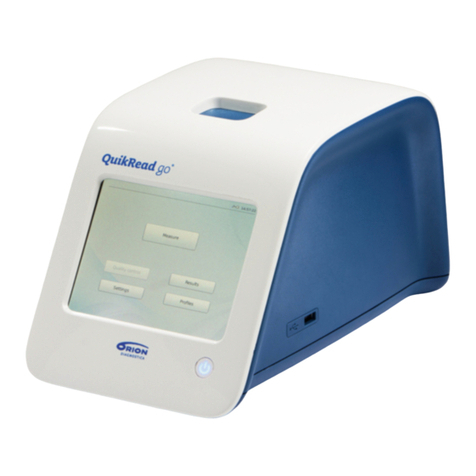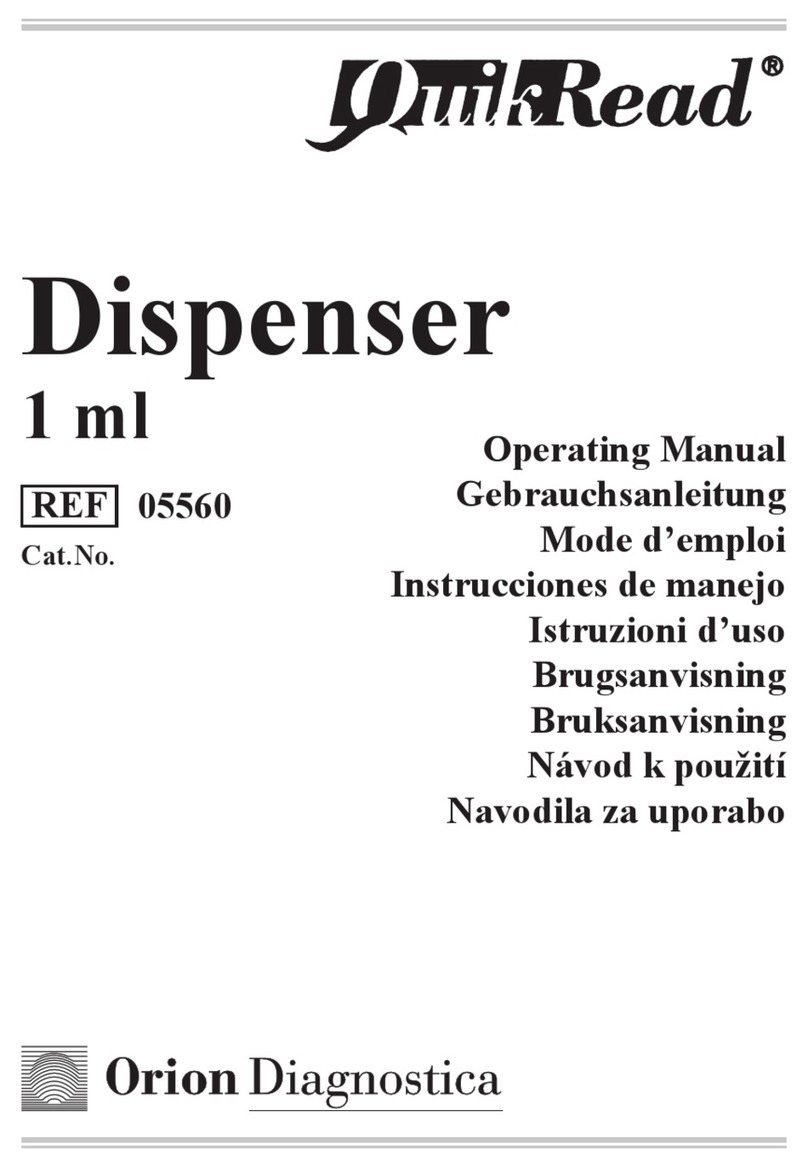5 Advertencias y precauciones:
Información de salud y seguridad
● Precaución: La ley federal restringe la venta de este dispositivo, que solo puede
realizarse por medio de un profesional legalmente autorizado o bajo sus órdenes.
● Para uso diagnóstico in vitro solamente.
● Solo para uso profesional.
● Solo para uso con receta.
● No fume, coma o beba en los locales donde se manipulen muestras o reactivos del
kit. Use indumentaria de protección personal adecuada y guantes desechables
al manipular las muestras de los pacientes y los reactivos del kit. Lávese bien las
manos cuando haya terminado de realizar el test.
● Evite el contacto con la piel y los ojos. En caso de contacto con la piel, lávese
inmediatamente con abundante agua.
● Todas las muestras de los pacientes y los controles deben manipularse como
material potencialmente infeccioso.
● El reactivo liolizado contiene <1% de azida sódica (Acuático crónico. 3). Nocivo
para los organismos acuáticos, con efectos nocivos duraderos (H412). Evitar su
liberación al medio ambiente (P273). Eliminar el contenido de acuerdo con la
legislación nacional y local (P501).
Los reactivos reconstituidos y líquidos contienen <0.1% de azida sódica, que no se
considera una concentración dañina. La azida sódica libera gases tóxicos en contacto
con los ácidos. Las azidas pueden reaccionar con las tuberías de metal, formando
compuestos explosivos. La acumulación de azidas puede evitarse mediante el
lavado con un gran volumen de agua cuando uno se deshace de los reactivos.
● Para consideraciones sobre eliminación, véase la Sección 15.
Precauciones analíticas
● No utilice el producto después de la fecha de expiración marcada en el empaque.
● No exceda los períodos de estabilidad indicados para los reactivos abiertos.
● El kit de PCR QuikRead go está destinado exclusivamente para su uso con el
equipo QuikRead go.
● No mezcle componentes de diferentes números de lote. Los componentes son
descartables; nunca reutilice los componentes si ya han sido empleados para
realizar un test.
● Al abrir un kit por primera vez, asegúrese de que las bolsas metálicas (2 uds.)
que protegen las cubetas estén intactas. Si la bolsa metálica está dañada, no
utilice las cubetas que están en su interior. Además, antes de utilizar una cubeta,
siempre debe asegurarse de que su cubierta de aluminio esté intacta.
● No toque las supercies planas claras de la parte inferior de la cubeta (la parte
óptica). Deseche cualquier cubeta que tenga huellas dactilares.
● Mantenga las tapas del Reactivo para PCR alejados de la humedad. Cierre el
tubo de aluminio inmediatamente después de sacar el número requerido de tapas
de reactivo.
● No derrame líquido en el pocillo de lectura del equipo.
6Recolección y preparación de la muestra
Recolección y volumen del material de muestra
Uso de los capilares y émbolos
El kit de PCR de QuikRead go contiene capilares
premedidos de 20 μL y émbolos. El émbolo se inserta
en el extremo de la franja azul. Luego el capilar se llena
hasta el tapón blanco. Tenga cuidado de asegurarse
de que no haya aire en el capilar y que el capilar esté
lleno hasta el tope del tapón blanco. Utilice un pañuelo
suave para limpiar cualquier residuo de la muestra del
exterior del capilar. Asegúrese de que el pañuelo suave
no extraiga nada de muestra del capilar.
Material de muestra Recolección de la muestra
Sangre entera
anti-coagulada
Utilice una muestra de sangre venosa recolectada en un
tubo que contiene Li-heparina o EDTA K2. Mezcle la sangre
entera dando vuelta el tubo varias veces y tome 20 μL con
un capilar. Solo se recomiendan los capilares incluidos en
el kit para agregar la muestra.
Plasma
Utilice plasma con EDTA K2/Li-heparina. Evite las muestras
claramente hemolizadas. Una hemólisis leve no afectará
los resultados del test. Solo se recomiendan los capilares
incluidos en el kit para agregar la muestra.
Suero
Evite las muestras claramente hemolizadas.
Una hemólisis leve no afectará los resultados del test.
Solo se recomiendan los capilares incluidos en el kit para
agregar la muestra.
Dilución de la muestra
Tipo de Muestra Instrucciones
Sangre entera No diluya las muestras de sangre entera.
Plasma/suero
Las muestras de suero o plasma pueden diluirse con una so-
lución de NaCl al 0.9% antes de añadir la muestra a la cubeta.
La relación de dilución recomendada es 1+3 (por volumen:
1 parte de muestra + 3 partes de NaCl al 0.9%).
Tome 20 μl de la muestra diluida en una cubeta, analice la
muestra y multiplique el resultado obtenido por 4.
Almacenamiento de la muestra
Material de muestra Almacenamiento
Sangre entera anticoagulada
(EDTA K2 y Li-heparina) 2–8 °C (36–46 °F) por 3 días
Plasma (EDTA K2 y Li-heparina) 2–8 °C (36–46 °F) por 7 días
Suero 2–8 °C (36–46 °F) por 7 días
Muestra (sangre entera con EDTA K2
y Li-heparina, plasma con EDTA K2
y Li-heparina, suero) en buffer
18–25 °C (64–77 °F) por 2 horas
Permita que las muestras alcancen la temperatura ambiente (18–25 °C, 64–77 °F)
antes del test.





























